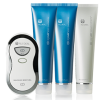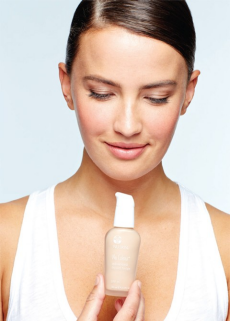Making Sense of Beauty Device Technologies
November 24, 2014

![]() At-home beauty devices are becoming increasingly prevalent, promising to reduce wrinkles, improve facial cleansing, and brighten skin. These handheld instruments are based on technologies and treatments conducted in spas, esthetician offices, and/or medical suites. Some of the most popular technologies include LEDs, cleansing brushes, microcurrents, and ultrasound.
At-home beauty devices are becoming increasingly prevalent, promising to reduce wrinkles, improve facial cleansing, and brighten skin. These handheld instruments are based on technologies and treatments conducted in spas, esthetician offices, and/or medical suites. Some of the most popular technologies include LEDs, cleansing brushes, microcurrents, and ultrasound.
Ultrasound
Ultrasonic technology is used to improve the appearance of skin by providing deep cleansing, exfoliation, and improved moisturization. One theory is that ultrasonic devices achieve this through what are called micro vibrations. These micro vibrations act as a micro-massage for the skin, which is said to promote detoxification and lymph drainage. With increased removal of waste in the skin, it is easier for topically applied products to penetrate and be absorbed by the skin. These deep tissue micro-massages may also improve skin tone, softness, and texture6.
Another predominant theory is that ultrasound waves help to improve skin’s appearance through a thermal effect. This thermal effect works by delivering heat into the deep skin tissue, which leads to improved blood circulation, increased metabolic activities, and accelerating cell regeneration. Stimulating the skin’s repair process may lead the skin to produce more structural proteins, like collagen, ultimately resulting in improved appearance6.
Cleansing Brushes
It is not uncommon for individuals to wash their face only to find more grime is still being removed when they look at their cotton ball during toning. These cleansing devices were developed to minimize, if not eliminate, this phenomenon. Ranging widely in price, these devices spin, rotate, vibrate, etc., claiming to cleanse the skin better than using hands alone.
The added benefits also include some physical exfoliation of the skin by the brush. This can help smooth the skin texture and increase skin radiance. Some are sold as part of anti-acne system, including topical products with anti-acne OTC ingredients, to help reduce acne lesions.
LEDs
Light emitting diodes (LEDs) are used in beauty devices providing different colors and benefits. For example, red or near infrared (600-950nm) is used for photobiomodulation to reduce the appearance of aging. The cellular respiratory chain found in the inner mitochondrial membrane contains chromophores for absorption. It is thought that cytochrome C oxidase is the primary photo acceptor for red light in human cells and increasing its oxidation results in an increase in electron transfer1,2.
Thus, red light is used for improving photoaged skin based on this theory. If red light improves the energy production of mitochondria that are responsible for cellular growth, stimulating the mitochondria of “old” skin cells can lead them to behave more like youthful, energetic skin cells.
Another example is blue LED used to treat acne. It has long been understood that acne is caused by the bacteria p.acnes which contain porphyrins. These porphyrins are excited by blue light resulting in production of reactive oxygen species (ROS) that ultimately kill p.acnes3. The reduction in bacteria improves or reduces acne prevalence.
While the use of blue and red LEDs can bring about improvements in skin appearance professionally, these technologies are also used in at-home beauty devices. The one down side to the home use devices is lower intensity. These can still be effective, but they take more time and patience. As such, compliance becomes an obstacle.

Microcurrents
Microcurrents can take different forms and is a general term to describe small electrical currents. These different types of currents can be used in cosmetics to improve the appearance of the skin. When talking about microcurrents there are three main types that are most commonly used to improve the appearance of skin: Alternating, Direct, and Galvanic.
With alternating currents (AC) the direction of flow is constantly being changed. The source constantly varies from a positive current to a negative current and back to positive current. This change in current flow is best represented by a sine wave. This type of current works directly on the tissues of the skin to help approve the appearance of the skin. Alternating currents are said to stimulate facial muscles, resulting in improved appearance.
Direct currents (DC) provide unidirectional flow that does not change from a positive or negative charge. It is considered a steady state current, but the current can pulsate where the intensity of the current can change but the direction of flow does not. Direct currents work directly on the tissues in the skin to stimulate the skin and improve its appearance.
Galvanic currents are considered to be a direct current. When used on the skin, this electrical technology is paired with topical products that have been specifically formulated to carry a like charge. Galvanic currents are a means to help deliver ingredients to the skin by using like charges to push ingredients for improved skin absorption. While sometimes likened to iontophoresis, which is used for transdermal delivery, these cosmetic treatments differ in strength and target the superficial layers of the skin. ■

Posted by Dale Kern
Senior Scientist, Global Nu Skin R&D
1. Yu W1, Naim JO, McGowan M, Ippolito K, Lanzafame RJ. Photomodulation of oxidative metabolism and electron chain enzymes in rat liver mitochondria. Photochem Photobiol. 1997 Dec;66(6):866-71.
2. Joseph Tafur, M.D. and Paul J. Mills, Ph.D. Low-Intensity Light Therapy: Exploring the Role of Redox Mechanisms. Photomed Laser Surg. Aug 2008; 26(4): 323–328.
3. He D1, Sassa S, Lim HW. Effect of UVA and blue light on porphyrin biosynthesis in epidermal cells. Photochem Photobiol. 1993 May;57(5):825-9.
4. Cheng N, Van Hoof H, Bockx E, Hoogmartens MJ, Mulier JC, De Dijcker FJ, Sansen WM, De Loecker W. The effects of electric currents on ATP generation, protein synthesis, and membrane transport of rat skin. Clin Orthop Relat Res. 1982 Nov-Dec;(171):264-72..
5. Steven Dayan, Shridhar Ventrapragada, Anil R. Shah. Effects Of Low Frequency Ultrasound On Epidermal And Dermal Structures: A Clinical and Histological Study downloaded from http://www.shahfacialplastics.com/effects-low-frequency.html on October 13, 2014.
You Might Also Like:
-
Advanced Liquid Finish and Advanced Tinted Moisturizer are formulated with anti-aging ingredients that help the skin look younger upon application. It does this by helping reduce the appearance of fine lines and wrinkles and helping sagging skin look tighter. Both products provide broad spectrum UV protection with SPF 15 and use light diffusing powder blends that allow light to be reflected from a...
